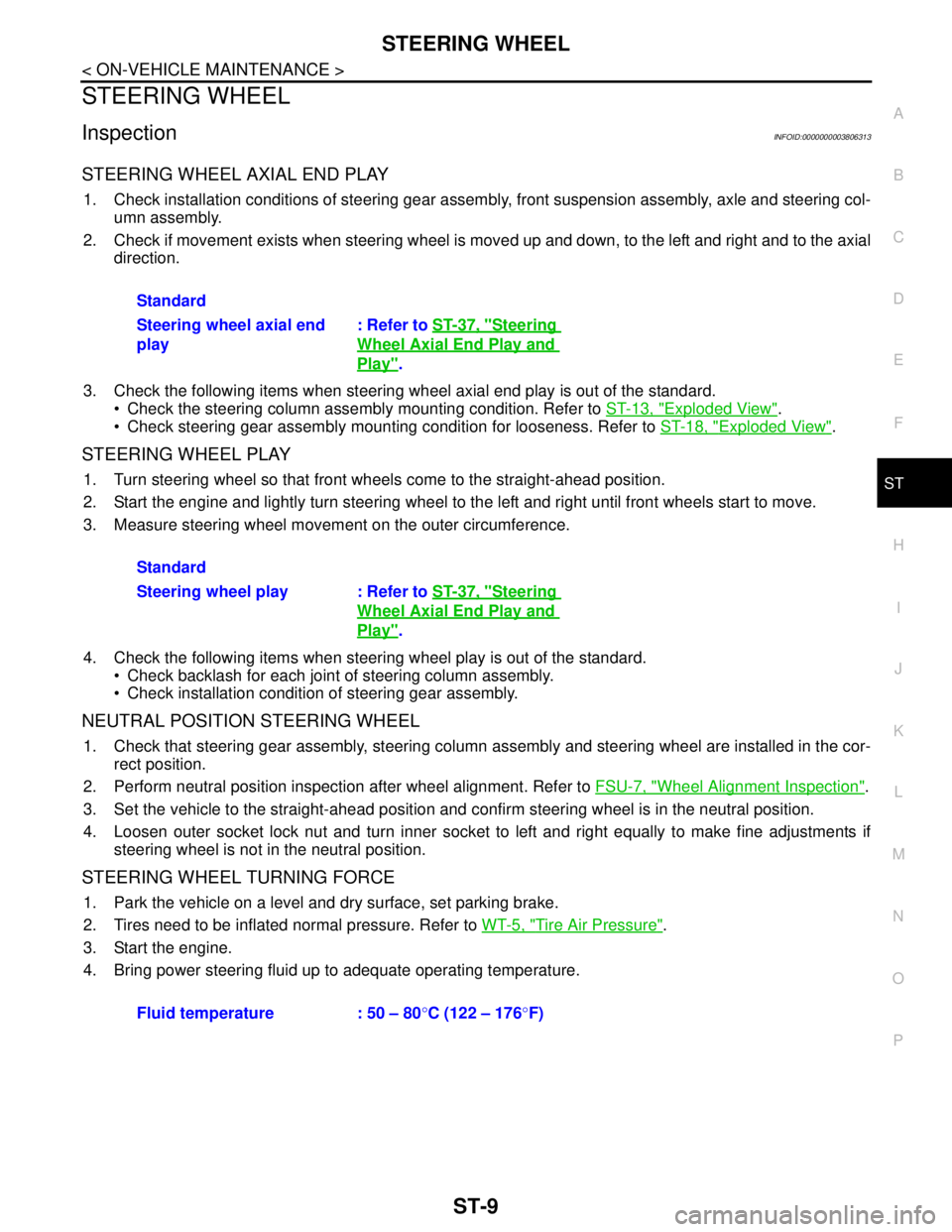2008 NISSAN TEANA brake light
[x] Cancel search: brake lightPage 3290 of 5121

MWI-36
< FUNCTION DIAGNOSIS >
DIAGNOSIS SYSTEM (METER)
- 0 : The condition that the warning/indicator lamp has been turned on 1 or more times after starting the
engine and waiting for 30 seconds.
- 1 - 39 : The number of times the engine was restarted after the 0 condition.
- NO W/L ON HISTORY : Stores NO (0) turning on history of warning/indicator lamp.
NOTE:
W/L ON HISTORY is not stored for approximately 30 seconds after the engine starts.
Brake warning lamp does not store any history when the parking the brake is applied or the brake fluid level
gets low.
Display Item
Display item Description
ABS W/L Lighting history of ABS warning lamp.
VDC/TCS IND Lighting history of VDC OFF indicator lamp.
SLIP IND Lighting history of SLIP indicator lamp.
BRAKE W/L Lighting history of brake warning lamp.
DOOR W/L Lighting history of door warning.
TRUNK/GLAS-H Lighting history of trunk warning.
OIL W/L Lighting history of oil pressure warning lamp.
C-ENG W/L Lighting history of malfunction indicator lamp.
C-ENG2 W/L This item is displayed, but cannot be monitored.
CRUISE IND Lighting history of CRUISE indicator lamp.
SET IND This item is displayed, but cannot be monitored.
CRUISE W/L This item is displayed, but cannot be monitored.
BA W/L This item is displayed, but cannot be monitored.
O/D OFF IND This item is displayed, but cannot be monitored.
ATC/T-AMT W/L This item is displayed, but cannot be monitored.
ATF TEMP W/L This item is displayed, but cannot be monitored.
CVT IND This item is displayed, but cannot be monitored.
SPORT IND Lighting history of SPORT indicator lamp.
4WD W/L This item is displayed, but cannot be monitored.
FUEL W/L Lighting history of low fuel level warning.
WASHER W/L This item is displayed, but cannot be monitored.
AIR PRES W/L This item is displayed, but cannot be monitored.
KEY G/Y W/L Lighting history of key warning lamp (green/yellow).
KEY R W/L Lighting history of key warning lamp (red).
KEY KNOB W/L This item is displayed, but cannot be monitored.
SYS FAIL W/L This item is displayed, but cannot be monitored.
SFT POSI W/L This item is displayed, but cannot be monitored.
HV BAT W/L This item is displayed, but cannot be monitored.
HEV BRAKE W/L This item is displayed, but cannot be monitored.
SFT OPER W/L This item is displayed, but cannot be monitored.
CHAGE W/L Lighting history of charge warning lamp.
OIL LEV LOW This item is displayed, but cannot be monitored.
DPF W/L This item is displayed, but cannot be monitored.
Page 3307 of 5121

MWI
COMBINATION METER
MWI-53
< ECU DIAGNOSIS >
C
D
E
F
G
H
I
J
K
L
MB A
O
P
ECU DIAGNOSIS
COMBINATION METER
Reference ValueINFOID:0000000003792588
VALUES ON THE DIAGNOSIS TOOL
Monitor Item Condition Value/Status
SPEED METER
[km/h]Ignition switch
ONWhile drivingEquivalent to speedometer reading
NOTE:
655.35 is displayed when the malfunc-
tion signal is received
SPEED OUTPUT
[km/h]Ignition switch
ONWhile drivingEquivalent to speedometer reading
NOTE:
655.35 is displayed when the malfunc-
tion signal is received
ODO OUTPUT
[km/h or mph]Ignition switch
ON—Equivalent to odometer reading in
combination meter
TACHO METER
[rpm]Ignition switch
ONWhile drivingEquivalent to tachometer reading
NOTE:
8191.875 is displayed when the mal-
function signal is received
FUEL METER
[lit]Ignition switch
ON— Values according to fuel level
W TEMP METER
[°C]Ignition switch
ON—Values according to engine coolant
temperature
NOTE:
215 is displayed when the malfunction
signal is input
ABS W/LIgnition switch
ONABS warning lamp ON On
ABS warning lamp OFF Off
VDC/TCS INDIgnition switch
ONVDC OFF indicator lamp ON On
VDC OFF indicator lamp OFF Off
SLIP INDIgnition switch
ONSLIP Indicator lamp ON On
SLIP indicator lamp OFF Off
BRAKE W/LIgnition switch
ONBrake warning lamp ON On
Brake warning lamp OFF Off
DOOR W/LIgnition switch
ONDoor warning ON On
Door warning OFF Off
TRUNK/GLAS-HIgnition switch
ONTrunk warning ON On
Trunk warning OFF Off
HI-BEAM INDIgnition switch
ONHigh-beam indicator lamp ON On
High-beam indicator lamp OFF Off
TURN INDIgnition switch
ONTurn signal indicator lamp ON On
Turn signal indicator lamp OFF Off
FR FOG INDIgnition switch
ONFront fog light indicator lamp ON On
Front fog light indicator lamp OFF Off
RR FOG INDIgnition switch
ONRear fog light indicator lamp ON On
Rear fog light indicator lamp OFF Off
LIGHT IND
Ignition switch
ONTail lamp indicator lamp ON On
Tail lamp indicator lamp OFF Off
Page 3321 of 5121

MWI
COMBINATION METER
MWI-67
< ECU DIAGNOSIS >
C
D
E
F
G
H
I
J
K
L
MB A
O
P
DTC IndexINFOID:0000000003792591
Function Specifications
Speedometer
Reset to zero by suspending communication. Tachometer
Water temperature gauge
Illumination controlWhen suspending communication, changes to nighttime
mode.
Information displayDoor open warning
The display turns off by suspending communication. Trunk open warning
Parking brake release warning
Instantaneous fuel warning When reception time of an abnormal signal is 2 seconds or
less, the last received datum is used for calculation to indi-
cate the result.
When reception time of an abnormal signal is more than two
seconds, the last result calculated during normal condition
is indicated. Average fuel consumption
Average vehicle speed
Travel distance
Buzzer The buzzer turns off by suspending communication.
Warning lamp/indicator
lampABS warning lamp
The lamp turns on by suspending communication. VDC OFF indicator lamp
SLIP indicator lamp
Brake warning lamp
High beam indicator lamp
The lamp turns off by suspending communication. Front fog light indicator lamp
Rear fog light indicator lamp
Turn signal indicator lamp
Light indicator lamp
Oil pressure warning lamp
Malfunction indicator lamp
CRUISE indicator lamp
SPORT indicator lamp
Key warning lamp
Display contents of CONSULT-III Diagnostic item is detected when ... Refer to
CAN COMM CIRCUIT
[U1000]When combination meter is not transmitting or receiving CAN communication signal
for 2 seconds or more.MWI-37,
"Diagnosis
Procedure"
CONTROL UNIT (CAN)
[U1010]When detecting error during the initial diagnosis of the CAN controller of combina-
tion meter.MWI-38, "Diagnosis
Procedure"
VEHICLE SPEED
[B2205]The abnormal vehicle speed signal is input from the ABS actuator and electric unit
(control unit) for 2 seconds or more.MWI-39, "Diagnosis
Procedure"
ENGINE SPEED
[B2267]If ECM continuously transmits abnormal engine speed signals for 2 seconds or
more.MWI-40, "Diagnosis
Procedure"
WATER TEMP
[B2268]If ECM continuously transmits abnormal engine coolant temperature signals for 60
seconds or more.MWI-41, "Diagnosis
Procedure"
Page 4399 of 5121

STEERING WHEEL
ST-9
< ON-VEHICLE MAINTENANCE >
C
D
E
F
H
I
J
K
L
MA
B
ST
N
O
P
STEERING WHEEL
InspectionINFOID:0000000003806313
STEERING WHEEL AXIAL END PLAY
1. Check installation conditions of steering gear assembly, front suspension assembly, axle and steering col-
umn assembly.
2. Check if movement exists when steering wheel is moved up and down, to the left and right and to the axial
direction.
3. Check the following items when steering wheel axial end play is out of the standard.
Check the steering column assembly mounting condition. Refer to ST-13, "
Exploded View".
Check steering gear assembly mounting condition for looseness. Refer to ST-18, "
Exploded View".
STEERING WHEEL PLAY
1. Turn steering wheel so that front wheels come to the straight-ahead position.
2. Start the engine and lightly turn steering wheel to the left and right until front wheels start to move.
3. Measure steering wheel movement on the outer circumference.
4. Check the following items when steering wheel play is out of the standard.
Check backlash for each joint of steering column assembly.
Check installation condition of steering gear assembly.
NEUTRAL POSITION STEERING WHEEL
1. Check that steering gear assembly, steering column assembly and steering wheel are installed in the cor-
rect position.
2. Perform neutral position inspection after wheel alignment. Refer to FSU-7, "
Wheel Alignment Inspection".
3. Set the vehicle to the straight-ahead position and confirm steering wheel is in the neutral position.
4. Loosen outer socket lock nut and turn inner socket to left and right equally to make fine adjustments if
steering wheel is not in the neutral position.
STEERING WHEEL TURNING FORCE
1. Park the vehicle on a level and dry surface, set parking brake.
2. Tires need to be inflated normal pressure. Refer to WT-5, "
Tire Air Pressure".
3. Start the engine.
4. Bring power steering fluid up to adequate operating temperature.Standard
Steering wheel axial end
play: Refer to ST-37, "
Steering
Wheel Axial End Play and
Play".
Standard
Steering wheel play : Refer to ST-37, "
Steering
Wheel Axial End Play and
Play".
Fluid temperature : 50 – 80°C (122 – 176°F)
Page 4485 of 5121
![NISSAN TEANA 2008 Service Manual TM-12
< BASIC INSPECTION >[CVT: RE0F09B]
INSPECTION AND ADJUSTMENT
INSPECTION AND ADJUSTMENT
ADDITIONAL SERVICE WHEN REPLACING CONTROL UNIT
ADDITIONAL SERVICE WHEN REPLACING CONTROL UNIT : Precaution NISSAN TEANA 2008 Service Manual TM-12
< BASIC INSPECTION >[CVT: RE0F09B]
INSPECTION AND ADJUSTMENT
INSPECTION AND ADJUSTMENT
ADDITIONAL SERVICE WHEN REPLACING CONTROL UNIT
ADDITIONAL SERVICE WHEN REPLACING CONTROL UNIT : Precaution](/manual-img/5/57391/w960_57391-4484.png)
TM-12
< BASIC INSPECTION >[CVT: RE0F09B]
INSPECTION AND ADJUSTMENT
INSPECTION AND ADJUSTMENT
ADDITIONAL SERVICE WHEN REPLACING CONTROL UNIT
ADDITIONAL SERVICE WHEN REPLACING CONTROL UNIT : Precaution for TCM
and CVT Assembly Replacement
INFOID:0000000003848916
CAUTION:
• Check if new data (Unit ID) are entered correctly after replacing CVT assembly and erasing data in
TCM. (Connect CONSULT-III, and then turn ignition switch OFF.)
When replacing CVT assembly or TCM, refer to the pattern table below and erase the EEPROM in the
TCM if necessary.
EEPROM ERASING PATTERNS
METHOD FOR ERASING THE EEPROM IN THE TCM
1. Turn ignition switch ON.
2. Move selector lever to “R” position.
3. Perform “Self-Diagnostic Results” mode for “TRANSMISSION”.
4. Press the brake pedal and turn the brake switch ON.
5. Press the accelerator pedal (0.5/8 - 4/8 throttle) not to exceed the half, and hold it in the half or less open
position. (This will set the closed throttle position signal to OFF and the wide open throttle position signal
to OFF.)
6. Perform “ERASE”.
7. Wait 3 seconds and then release the accelerator pedal.
8. Turn ignition switch OFF.
METHOD FOR WRITING DATA FROM THE ROM ASSEMBLY IN THE TRANSAXLE
In the following procedure, the TCM reads data from the ROM assembly and writes it to the EEPROM in the
TCM.
1. Erase the EEPROM in the TCM.
2. Move selector lever to “P” position.
3. Turn ignition switch ON.
CHECK METHOD
Standard: About 2 seconds after the ignition switch ON, the CVT indicator lamp lights up for 2 seconds.
Non-standard: Even after the ignition switch ON, the CVT indicator lamp does not light up after 2 seconds or
illuminates immediately.
CAUTION:
Perform in the “P” or “N” position.
Action for Non-standard
Replace the CVT assembly.
Replace the TCM.
CVT assembly TCM Erasing EEPROM in TCM Remarks
Replaced Replaced Not requiredNot required because the EEPROM in the TCM is in
the default state. (CVT assembly must be replaced
first.)
Not replaced Replaced Not requiredNot required because the EEPROM in the TCM is in
the default state.
Replaced Not replaced RequiredRequired because data has been written in the EE-
PROM in the TCM and because the TCM cannot write
data from the ROM assembly in the transmission.
Page 4625 of 5121
![NISSAN TEANA 2008 Service Manual TM-152
< ON-VEHICLE MAINTENANCE >[CVT: RE0F09B]
CVT POSITION
CVT POSITION
Inspection and AdjustmentINFOID:0000000003849084
INSPECTION
1. Move selector lever to “P” position, and turn ignition swit NISSAN TEANA 2008 Service Manual TM-152
< ON-VEHICLE MAINTENANCE >[CVT: RE0F09B]
CVT POSITION
CVT POSITION
Inspection and AdjustmentINFOID:0000000003849084
INSPECTION
1. Move selector lever to “P” position, and turn ignition swit](/manual-img/5/57391/w960_57391-4624.png)
TM-152
< ON-VEHICLE MAINTENANCE >[CVT: RE0F09B]
CVT POSITION
CVT POSITION
Inspection and AdjustmentINFOID:0000000003849084
INSPECTION
1. Move selector lever to “P” position, and turn ignition switch ON (engine stop).
2. Check that selector lever can be shifted to other than “P” position when brake pedal is depressed. Also
check that selector lever can be shifted from “P” position only when brake pedal is depressed.
3. Move selector lever and check for excessive effort, sticking, noise or rattle.
4. Check that selector lever stops at each position with the feel of engagement when it is moved through all
the positions. Check that the actual position of selector lever matches the position shown by shift position
indicator and manual lever on the transaxle.
5. The method of operating selector lever to individual positions
correctly should be as shown.
6. When selector button is pressed in “P”, “R”, “N”, “D” or “L” posi-
tion without applying forward/backward force to selector lever,
check button operation for sticking.
7. Check that back-up lamps illuminate only when selector lever is
placed in the “R” position.
8. When in “R” position, check that back-up lamps illuminate even
when the selector lever is pushed toward the “P” position.
CAUTION:
Check the lighting without pressing shift button.
9. Check that back-up lamps do not illuminate when selector lever is pushed toward the “R” position when in
the “P” or “N” position.
CAUTION:
Check the lighting without pressing shift button.
10. Check that the engine can only be started with selector lever in the “P” and “N” positions.
11. Check that transaxle is locked completely in “P” position.
ADJUSTMENT
1. Move selector lever to “ P” position.
CAUTION:
Turn wheels more than 1/4 rotations and apply the park
lock.
2. Loosen the control cable nut (A).
3. Place manual lever (B) to “P” position.
CAUTION:
Never apply any force to manual lever.
4. Tighten the control cable nut. Refer to TM-157, "
Exploded View".
CAUTION:
Fix manual lever when tightening.
JPDIA0343GB
JPDIA0794ZZ
Page 4652 of 5121
![NISSAN TEANA 2008 Service Manual INSPECTION AND ADJUSTMENT
TM-179
< BASIC INSPECTION >[CVT: RE0F10A]
C
E
F
G
H
I
J
K
L
MA
B
TM
N
O
P
INSPECTION AND ADJUSTMENT
ADDITIONAL SERVICE WHEN REPLACING CONTROL UNIT
ADDITIONAL SERVICE WHEN REP NISSAN TEANA 2008 Service Manual INSPECTION AND ADJUSTMENT
TM-179
< BASIC INSPECTION >[CVT: RE0F10A]
C
E
F
G
H
I
J
K
L
MA
B
TM
N
O
P
INSPECTION AND ADJUSTMENT
ADDITIONAL SERVICE WHEN REPLACING CONTROL UNIT
ADDITIONAL SERVICE WHEN REP](/manual-img/5/57391/w960_57391-4651.png)
INSPECTION AND ADJUSTMENT
TM-179
< BASIC INSPECTION >[CVT: RE0F10A]
C
E
F
G
H
I
J
K
L
MA
B
TM
N
O
P
INSPECTION AND ADJUSTMENT
ADDITIONAL SERVICE WHEN REPLACING CONTROL UNIT
ADDITIONAL SERVICE WHEN REPLACING CONTROL UNIT : Service After Replac-
ing TCM and Transaxle Assembly
INFOID:0000000003806346
SERVICE AFTER REPLACING TCM AND TRANSAXLE ASSEMBLY
Perform the applicable service according to the following sheet when replacing TCM or transaxle assembly.
CAUTION:
Never start the engine until the service is completed.
“TCM-POWER SUPPLY [P1701]” may be indicated soon after replacing TCM or transaxle assembly
(after erasing the memory at the pattern B). Restart the self-diagnosis after erasing the self-diagnosis
result. Check that no error is detected.
NOTE:
Old unit means that the unit has been already used for another vehicle.
PATTERN A
1. Shift the selector lever to “P” position after replacing TCM. Turn the ignition switch ON.
2. Check that the shift position indicator in the combination meter turns ON (It indicates approximately 1 or 2
seconds after turning the ignition switch ON.)
Check the following items if the shift position indicator does not turn ON. Repair or replace the shift posi-
tion indicator if necessary.
- The harness between TCM and ROM ASSY in the transaxle assembly is open or shorted.
- Cable disconnected, loosen, or bent from the connector housing.
PATTERN B
1. Turn the ignition switch ON after replacing each part.
2. Start engine.
CAUTION:
Never start driving.
3. Select “Data Monitor” mode for “TRANSMISSION”.
4. Warm up the transaxle assembly until “ATFTEMP COUNT” indicates 47 [approximately 20°C (68°F)] or
more. Turn the ignition switch OFF.
5. Turn the ignition switch ON.
CAUTION:
Never start engine.
6. Select “Self Diagnostic Results” mode for “TRANSMISSION”.
7. Shift the selector lever to “R” position.
8. Depress slightly the accelerator pedal (Pedal angle: 2/8) while depressing the brake pedal.
9. Perform “Erase”.
10. Shift the selector lever to “R” position after replacing TCM. Turn the ignition switch OFF.
11. Wait approximately 10 seconds after turning the ignition switch OFF.
12. Turn the ignition switch ON while shifting the selector lever to “R” position.
CAUTION:
Never start engine.
13. Select “Special Function” mode for “TRANSMISSION”.
14. Check that the value on “CALIBRATION DATA” is the same as the data after erasing “Calibration Data”.
TCM CVT assembly Service pattern
Replace the new unit. Do not replace the unit. “PATTERN A”
Do not replace the unit. Replace either an old unit or new unit.
“PATTERN B”
Replace the old unit.Do not replace the unit.
Replace either an old unit or new unit.
Replace the new unit. Replace either an old unit or new unit. “PATTERN C”
Page 4787 of 5121
![NISSAN TEANA 2008 Service Manual TM-314
< ON-VEHICLE MAINTENANCE >[CVT: RE0F10A]
CVT POSITION
CVT POSITION
Inspection and AdjustmentINFOID:0000000003806512
INSPECTION
1. Place selector lever in “P” position, and turn ignition swi NISSAN TEANA 2008 Service Manual TM-314
< ON-VEHICLE MAINTENANCE >[CVT: RE0F10A]
CVT POSITION
CVT POSITION
Inspection and AdjustmentINFOID:0000000003806512
INSPECTION
1. Place selector lever in “P” position, and turn ignition swi](/manual-img/5/57391/w960_57391-4786.png)
TM-314
< ON-VEHICLE MAINTENANCE >[CVT: RE0F10A]
CVT POSITION
CVT POSITION
Inspection and AdjustmentINFOID:0000000003806512
INSPECTION
1. Place selector lever in “P” position, and turn ignition switch ON (engine stop).
2. Check that selector lever can be shifted to other than “P” position when brake pedal is depressed. Also
check that selector lever can be shifted from “P” position only when brake pedal is depressed.
3. Move the selector lever and check for excessive effort, sticking, noise or rattle.
4. Check that selector lever stops at each position with the feel of engagement when it is moved through all
the positions. Check that the actual position of the selector lever matches the position shown by the shift
position indicator and the manual lever on the transaxle.
5. The method of operating the selector lever to individual posi-
tions correctly should be as shown.
6. When selector button is pressed in “P”, “R”, “N”, “D” or “L” posi-
tion without applying forward/backward force to selector lever,
check button operation for sticking.
7. Check that back-up lamps illuminate only when selector lever is
placed in the “R” position.
8. When in “R” position, check that back-up lamps illuminate even
when the selector lever is pushed toward the “P” position.
CAUTION:
Check the lighting without pressing shift button.
9. Check that the back-up lamps do not illuminate when selector lever is pushed toward the “R” position
when in the “P” or “N” position.
CAUTION:
Check the lighting without pressing shift button.
10. Check that the engine can only be started with the selector lever in the “P” and “N” positions.
11. Check that transaxle is locked completely in “P” position.
ADJUSTMENT
1. Place selector lever in “ P” position.
CAUTION:
Turn wheels more than 1/4 rotations and apply the park lock.
2. Loosen nut (A) and place manual lever (B) in “P” position.
CAUTION:
Never apply any force to the manual lever.
3. Tighten nut. Refer to TM-319, "
Exploded View".
CAUTION:
Fix the manual lever when tightening.
JPDIA0343GB
JPDIA0780ZZ